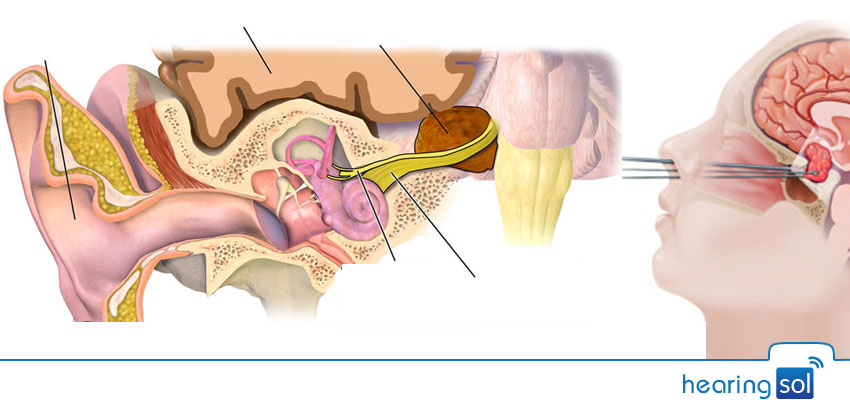
Vestibular Schewanno is a type of tumor that caused by Schwann Cells. This Tumor (If left untreated) can be very dangerous to the sufferer by causing hearing loss, loss of balance, and even facial paralysis.
In this article, we are going to read all about Vestibular Schwannoma, its types, causes, how it is diagnosed, it’s treatment, and its impact on the sufferer’s life.
- What Is The Vestibular Schwannoma (Acoustic Neuroma)?
- Features of Vestibular Schwannoma
- Types of Acoustic neuroma
- Classification of Vestibular Schwannoma (VS)
- Vestibular Schwannoma Signs And Symptoms
- Causes of Acoustic Neuroma (Vestibular Schwannoma)
- How is Acoustic Neuroma is Diagnosed?
- Treatment for Acoustic Neuromas (Vestibular Schwannomas)
- Change in Life After Acoustic Neuroma
You can purchase the latest hearing aids at a fair price through HearingSol, If you need any assistance or you have a query regarding Vestibular Schwannoma (Acoustic Neuroma) or Hearing Loss, feel free to call us at +91-9327901950. We are always here to help you.
So let’s begin without wasting any more time.
What Is The Vestibular Schwannoma (Acoustic Neuroma)?
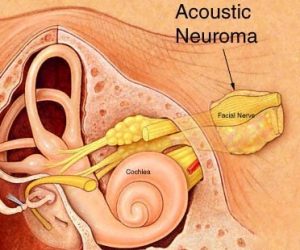
A Vestibular Schwannoma is also known as Acoustic Neuroma. It also has other names such as acoustic neurilemoma and acoustic neurinoma. It is benign(not harmful) and grows slowly from an overproduction of Schwann cells.
The function of Schwann cells is to help in supporting neurons in the peripheral nervous system. Usually, this mild slow-growing tumor of the nerve connects to the inner ear to the brain.
As the vestibular schwannoma grows, it affects the hearing and balance nerves, usually causing unilateral or asymmetric hearing loss, tinnitus, and loss of balance.
This nerve runs from the brain to the ear and controls hearing and balance. They are nearly always slow-growing, do not spread. Therefore they are thought of as benign tumors.
With each passing time, the growing tumor starts affecting the face sensation nerve or the trigeminal nerve which later leads to facial numbness. Acoustic Neuroma also causes facial weakness by interfering with the facial nerve.
Often they have been there a long time by the time doctors diagnose it. But in case acoustic neuromas grow and become large, they eventually occupy a large section of the cerebellopontine angle. Or turns out to be life-threatening by pressing against nearby brain structures including the cerebellum and brainstem.
Fact – An average person in their lifetime has a risk of about 1 in 1000 of developing Vestibular Schwannoma.
According to the latest research at the Mayo Clinic, in Rochester Minn (Marinelli et al, 2018), the prevalence of neuroma tumor was 1.5 in 100,000 during the first decade (which is 1966-1976) and the number later increased to 4.2 in 100,000 in the latest decade (around 1996-2016). This result is due to the latest diagnostic technology such as MRI scanners.
Features of Vestibular Schwannoma
- The most common age of acoustic tumors is 40 to 60 years although it can occur at 20 to 30 years when it associates with neurofibromatosis type 2.
- Most schwannoma tumor is sporadic tumors. Sporadic cancers are those which are not caused because of inherited gene mutation.
- Both male and female genders are equally affected.
- This brain tumor is radio-resistant.
- The gene mainly responsible for schwannoma development has been separated to chromosome 22q12, which later codes for vestibular schwannoma(tumor suppressor Merlin).
- In almost 90 percent of the cases, this auditory neuroma is unilateral, and in rest, cases may be in Vonrecking Hausen disease(type 2 NF) is bilateral.
Types of Acoustic neuroma
1. Unilateral acoustic neuromas
It affects only one ear. Being the most common type of inner ear tumor, acoustic neuroma symptoms may start developing at any age.
This tumor is found in around 8 % of all tumors inside the skull. Unilateral vestibular schwannomas may be caused due to nerve damage result of environmental factors.
Although, until now there is no environmental factor found to be responsible for acoustic neuromas. In most of the cases it is not hereditary and also occur at irregular intervals or sporadically.
2. Bilateral Acoustic Neuromas
It affects both hearing nerves and also is hereditary. They bilateral vestibular schwannoma is caused by a genetic disorder called neurofibromatosis type 2 (NF2).
Therefore, almost half the patients of this inner ear tumor inherited from either of the affected father or mother. And rest half of the patients became a victim of some kind of mutation.
So, there is a 50 % probability of inheriting this tumor. Individuals with neurofibromatosis type 2 generally show spinal cord and multiple brain-related tumors.
In these cases patients can also develop tumors of the nerves which are necessary for speech, swallowing, eye, facial sensation, and facial movement.
Unilateral and bilateral acoustic neuromas both caused the loss of the function of a gene on chromosome 22 which responsible for the production of a protein that in turns controls Schwann cell’s growth.
During malfunction of the gene, the growth of Schwann cell gets uncontrolled, which therefore results in a tumor. Researchers may also believe that this gene can also help in controlling other tumors’ growth.
In bilateral vestibular schwannomas patients, the damaged gene on chromosome 22 is inherited. In some of the cases, many of the professionals found this gene completely not functional.
Difference Between Unilateral and Bilateral Acoustic Neuroma
- Where Unilateral acoustic neuroma patients show symptoms between 30 to 60 years and on the other hand bilateral acoustic neuroma with NF2 usually develops symptoms in their very early adulthood.
- Unilateral vestibular schwannomas are non-hereditary whereas bilateral vestibular schwannoma is hereditary.
Classification of Vestibular Schwannoma (VS)
This table shows the classification of vestibular neuroma according to its size. The data in the table is based on the CT based size of the biggest extra metal diameter.
| Instrumental tumor | Extrameatal size | mm |
| Grade 1 | Small | 1-10 |
| Grade 2 | Medium | 11-20 |
| Grade 3 | Moderately large | 21-30 |
| Grade 4 | Large | 31-40 |
| Grade 5 | Gaint | > 40 |
Vestibular Schwannoma Signs And Symptoms
Vestibular Schwannoma (Acoustic neuromas) are usually slow-growing tumors and signs of a brain tumor often develop over several years. The most common acoustic neuroma symptoms are:
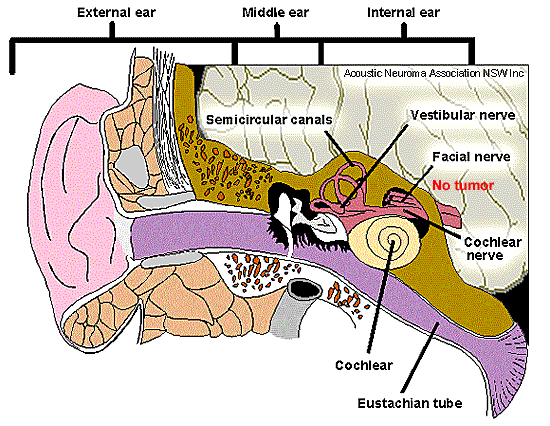
Clinical Symptoms
- Otological Stage ( less than 2 cm),
- Trigeminal nerve or Stage of V nerve participation ( 2-2.5 cm),
- Stages of the Brainstem and cerebellar compression (2.5-4 cm),
- Stages of rising of intracranial pressure,
- Terminal Stage
Stage 1 – Otological Stage
- Tinnitus:- Hearing loss or ringing on one side, can’t hear high-frequency sounds. Not all tinnitus patients have an acoustic neuroma and not all AN patients have tinnitus.
- Hearing loss:- According to research published in NCBI, hearing impairment was the first symptom found in most of the cases of this ear tumor. Around 90% of people with acoustic neuroma symptoms is unilateral sensorineural hearing loss. It means there is damage to the inner ear or nerve pathways from the inner ear to the brain.
- Balance:- Balance problems or unsteadiness. During the growth of a tumor, anxiety, and balance problems causing symptoms of depression. It also causes vertigo.
- The pressure in the ear:- Vestibular schwannoma patients sometimes feel pressure in the ear or full.
- A headache:- Headaches, clumsy gait, and mental confusion. Headaches are not a common symptom, also tending to occur only in cases of larger tumors.
- Facial weakness or paralysis:- Facial numbness and tingling with possible, though rare, paralysis of a facial nerve. Larger tumors can also press on the trigeminal nerve, causing facial numbness and tingling.
Read more – Ear Barotrauma: Pressure in The Ears (Causes Symptoms & Treatment)
Stage 2 – Trigeminal Nerve Involvement
- Tumor size becomes 2 to 2.5 cm
- Irritation starts in the eye
- A cold sensation on the face
- The sensation of tingling, pain, and face becomes numb
Stage 3 – Brainstem and Cerebellar Compression (2.5-4 cm)
- Gait disturbance
- Ataxia
- Dysmetria
- Nystagmus
- Past pointing
- Dysdiadokokinesis
- Intention Tremors
Stage 4 – Rising of Intracranial Pressure
- A headache occipital
- Vomiting
- Neck rigidity
- Papilloedema ( Optic disc swelling)
Stage 5 – Termination
Termination stage involves the failure of vital centers in the brain stem
Causes of Acoustic Neuroma (Vestibular Schwannoma)
The cause of acoustic neuromas is unknown. In a small number of people, we can link it to an inherited (genetic) condition called neurofibromatosis type 2.
People who have a disease called neurofibromatosis type 2 (NF2) are at higher risk. NF2 can run in families. In this situation, acoustic neuromas usually develop on the hearing nerves on both sides of the head.
These tumors can be caused by:
- Constant or continuous exposure to loud noise like loud music, work-related sound.
- Neck or face radiation can lead to acoustic neuroma many years later.
How is Acoustic Neuroma is Diagnosed?
Because symptoms of these tumors simulate other middle and inner ear conditions, it may cause it difficult to diagnose.
Computerized tomography (CT) and magnetic resonance imaging (MRI) scans help to determine the location and size of a tumor. Early diagnosis offers the best opportunity for successful treatment.
- Hearing test (audiometry):- Audiometry exam is one of the most useful diagnostic tests. This tests your ability of hearing, how well the patient hears sounds and speech. Sound varies, based on their loudness and the speed of sound wave vibrations. Our ears have three distinct parts: the outer, middle, and inner ear. Audiometry tests can detect whether you have a sensorineural hearing loss or conductive hearing loss. At the time of this test, the patient listens to sounds and speech while wearing earphones attached to the audiometer records and measure hearing function. Basically, it shows the graph which gives a detailed description of your hearing ability.
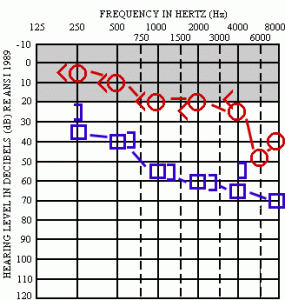
- Brainstem auditory evoked the response (BAER):- This test can help to diagnose hearing loss and nervous disorder. BAER test helps doctors to measure brain wave activity as a response to clicks or certain tones. This test is quick and has no risk. Yo simply lie back on chair or bed and keep still the doctor attaches small electrodes, this electrode connects to a machine that records your brain’s response to these sounds. The result of your test shows a sharp point in your brain activity each time you heard sounds or other tones. If your results show flatlines when you heard sounds, it may indicate that you have hearing loss.
- Scans of the head:- When the condition is abnormal and it shows a progressively worsening pattern. Then, in those cases, the doctor will suggest further tests such as gadolinium-enhanced MRI (magnetic resonance imaging), and ABR (auditory brainstem response) which can build the diagnosis.
You can do MRIs on different parts of your body. If an acoustic neuroma is present, the tumor pigment is more than normal brain tissue and show clearly on the scan.
The MRI commonly shows a densely enhancing tumor in the internal auditory canal. MRI does not involve x-rays, it uses magnetic fields and radio waves.
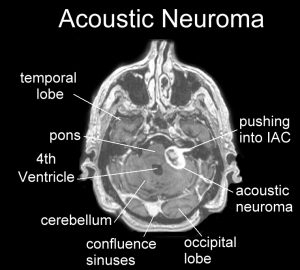
- Caloric test – Caloric test can be normal in case the tumor is small. Therefore, in 96 percent of the individuals, the response is absent or diminished. This test observes the superior vestibular nerve through the lateral semi-circular canal.
Treatment for Acoustic Neuromas (Vestibular Schwannomas)
Acoustic Neuroma treatment depends on your age, general health, hearing status, tumor size, and how are the symptoms affecting you and your health. Vestibular schwannoma treatment may involve observation, surgical removal of the tumor, or the use of radiation to stop the tumor from growing.
A team of specialists will plan your treatment. This will usually include:
- Neurosurgeon:- Neurosurgeon is a medical specialist who specializes in the diagnosis and surgical treatment of a disorder. It includes congenital anomalies, trauma, tumors, vascular disorders, infections of the brain or spine, stroke, or degenerative diseases of the spine.
- Clinical Oncologist:- An oncologist who is trained to manage cancer patients with radiotherapy and chemotherapy. They use both radiotherapy and also what is known as systemic therapy. This includes chemotherapy, hormone therapy, and biological agents, all of which they use to treat cancer.
- Neuro-Otologist:- They treat neurological disorders of the ear. An ear, nose, and throat doctor who specializes in treating illnesses affecting the skull base and nearby nerves.
- Specialist Nurse:– Who gives information and support to people with brain tumors.
Your specialist will brief your treatment. They will tell you about the benefits and disadvantages and possible risks. However, here is the following treatment:
1. Observation (Watch and wait)
This option may be preferred in affected individuals where no associated symptoms are present or where a small tumor is not grown or growing at a slow rate.
This period of observation may be called “watch and wait”. 40% to 50% for AN patient, tumor growth or progression of symptoms will prompt the need for surgery or radiosurgery.
2. Surgery
Surgeons have developed a different type of craniotomy to remove Acoustic Neuromas. A surgical craniotomy may use a suboccipital, Translabyrinthine approach or middle fossa approach.
The goal of surgery is to remove a tumor, preserve the facial nerve to prevent facial paralysis, and keep hearing when possible.
Surgery priorities are: first, the maintenance of facial nerve function; second, the preservation of socially useful hearing in the affected ear; and third, complete tumor removal.
While total tumor removal may result in a cure, it also carries a higher risk of hearing which may lead to hearing loss and facial nerve damage as a result of this surgery.
The following are three Surgical procedures way to an acoustic neuroma: suboccipital, Translabyrinthine, and middle fossa.
- Translabyrinthine, which involves making an incision behind the ear and removing the bone behind the ear and some of the middle ear. Specialists use this to treat tumors larger than 3 centimeters. The translabyrinthine approach also provides direct exposure of a tumor without the need to retract the normal brain. It is only indicated for patients who have a profound hearing loss or very large tumors with a significant Intracanalicular component. Also, there is a downside to this technique, that it results in a permanent hearing loss.
- Sub-occipital also knows as Retrosigmoid, which involves exposing the back of a tumor by opening the skull near the back of the head. It helps to remove tumors of any size while preserving hearing. It can be effective for hearing preservation and decompressing the brain when a large tumor has grown.
- Middle fossa, help to remove a small piece of bone above the ear canal. This approach has the best record for preserving hearing when resecting tumors less than 2 cm in diameter. Also using this approach may enable surgeons to preserve a patient’s hearing.
3. Cochlear Implantation
There is a very less probability that patients of acoustic neuroma might need a cochlear implant. In case the patient has an acoustic tumor in the only hearing ear, which means he has only left vestibular schwannoma or right vestibular schwannoma.
Or after surgery to remove bilateral acoustic neuromas. Cochlear implantation is only possible in case there is an intact cochlear nerve, and at the time of acoustic tumor removal, the cochlear implantation is done, before the cochlea ossifies.
Change in Life After Acoustic Neuroma
Acoustic neuroma is a non-cancerous tumor. Patients suffering from acoustic neuroma may experience hearing impairment, facial weakness, vertigo, the pressure in the ear, headache, and tinnitus.
In the case of patients having large tumors can have a probability of another type of neurological problem. For ear neuroma treatment individuals require brain surgery for the removal of the tumor.
If the patient chooses not to go through surgery then he needs to have periodic imaging studies to know the circumstances in case the tumor left without any treatment.
You can purchase the latest hearing aids at a fair price through HearingSol, If you need any assistance or you have a query regarding Vestibular Schwannoma (Acoustic Neuroma) or Hearing Loss, feel free to call us at +91-9327901950. We are always here to help you.

 Reviewed by Mr. Ranjeet Kumar
Sr. Audiologist, Speech Therapist & Cochlear Implant Specialist, BASLP on
Reviewed by Mr. Ranjeet Kumar
Sr. Audiologist, Speech Therapist & Cochlear Implant Specialist, BASLP on